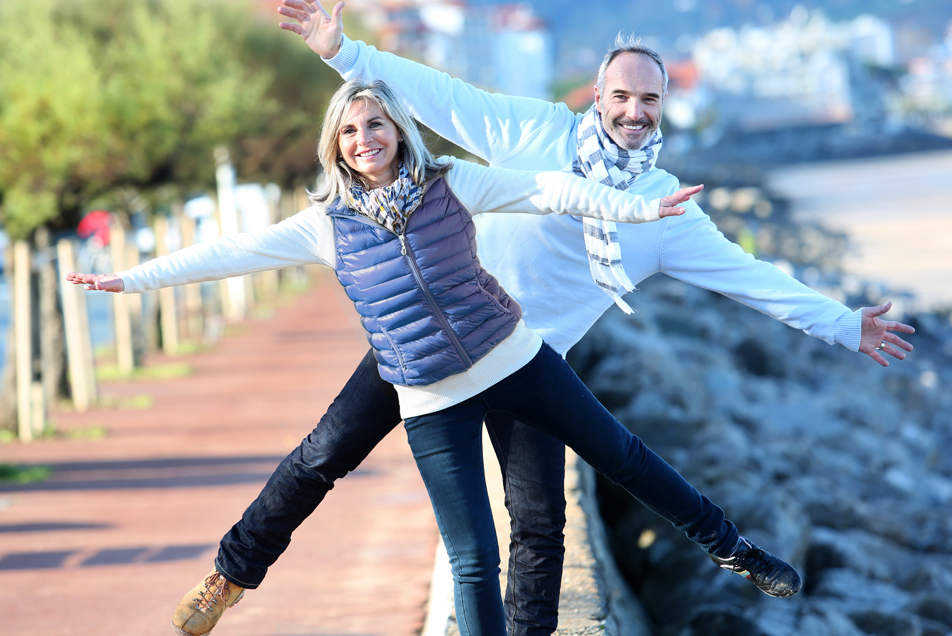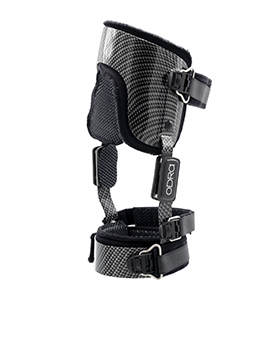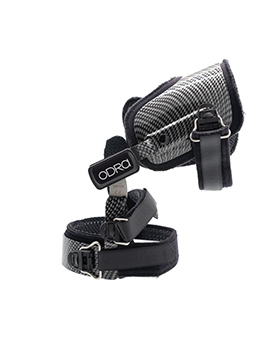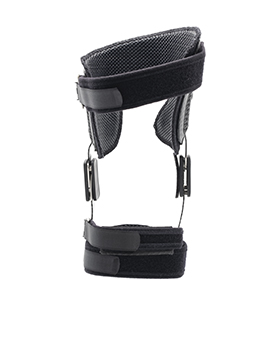Odra knee brace for knee osteoarthritis

The Odra brace for knee osteoarthritis has been designed to provide symptomatic treatment for osteoarthritis of the medial femorotibial compartment.
Morphological
An orthotist produces the knee brace either by overmoulding or using digital scanning equipment to ensure a perfect fit over the patient’s lower limb.
Unique and patented mode of action
Developed by PROTEOR and patented worldwide, the Odra orthosis improves knee mobility by maintaining a gap between the upper and lower leg bones.. This reduction in intra-articular pressure relieves the pain that occurs, if the cartilage is absent, when these bones rub against each other.
The name of the Odra orthosis describes how it works: it is an Orthosis that uses Distraction andRotation to relieve Arthritis.
Medial distraction: When the leg is extended, during the stance phase, the medial hinge elongates the orthosis to produce a DISTRACTION between the femur and the tibia. The effect of this elongation is to reduce the pressure on the painful compartment of the knee.
Outward rotation: Concurrently to this distraction, the pivot point on the lateral hinge shifts backwards to produce an outward ROTATION of the foot. This rotation counters the abduction moment which can cause painful knee joint space narrowing.
Dynamic orthosis
The knee brace only acts on the knee when the leg is extended, i.e. when the patient is active.
Well tolerated to ensure good compliance
One of the findings of the ERGONOMIE trial conducted in France was that the orthosis was worn, on average, for >5 h/day, 6 days a week. This corresponded closely to the instructions given to the patients at inclusion (6 h/day).
Scientifically proven effectiveness
Numerous independent and internationally recognised studies have proven the effectiveness of the Odra orthosis. Some key conclusions of these studies are given below:
Xavier Robert-Lachaine, et al, Three‐month efficacy of three knee braces in the treatment of medial knee osteoarthritis in a randomized crossover trial (access the abstract: click here)
Conclusions of the study:
- All three orthoses relieved pain and stiffness and improved functional status and quality of life.
- Compared with the two other types of orthosis, the Odra custom-made orthosis was more comfortable, encouraged a higher level of treatment compliance and induced a greater reduction in KAM (knee adduction moment).
Ornetti P, et al, Clinical effectiveness and safety of a distraction-rotation knee brace for medial knee osteoarthritis, Annals of Physical and Rehabilitation Medicine (access the study: click here)
The ERGONOMIE randomized control trial (coordinated by Dijon university hospital, 2015/2017) assessed 120 patients and demonstrated that use of the Odra orthosis significantly relieved pain, improved quality of life and encouraged a return to sporting activities.
Conclusions of the study:
The ERGONOMIE RCT showed that the combination of Odra + usual care is a promising therapeutic strategy characterized by high levels of acceptance and tolerance by patients with medial knee osteoarthritis.
The overall improvement in KOOS scores in the Odra group showed that the patients’ overall function was improved by wearing the device for one year. There was also a clear improvement in 3 domains in the OAKHQOL questionnaire for the Odra group.
The ERGONOMIE RCT thus demonstrated a significant improvement in pain and function in the Odra group vs the usual care alone group.
The results confirm that the device is safe to use and suggest that its use is associated with a good cost-effectiveness ratio.
Although some side effects were reported, the high level of treatment compliance after wearing the device for one year reveals good medium-term tolerance. The estimated percentage of patients who continued to use the orthosis daily at 1 year was particularly high (84%) compared with other studies found in the literature.
From a societal perspective, Odra has a cost-utility ratio that has not so far been demonstrated for any other orthosis used to treat medial knee osteoarthritis.
The patients in the usual care alone group were offered the opportunity to try out the Odra orthosis at the end of the trial.
Ornetti P & Al, Clinical effectiveness and safety of a distraction-rotation knee brace for
medial knee osteoarthritis, Annals of Physical and Rehabilitation Medicine (access the abstract: click here)
Conclusions of the study:
The results of this study demonstrate the short- and medium-term effectiveness of the Odra custom-made orthosis with regard to relieving pain and improving function
The Odra orthosis appears to have a Benefit-Risk ratio that is better than those of the reference orthoses (unloader braces, three-point braces, etc.)
Dessery Y, et al, Comparison of three knee braces in the treatment of medial knee osteoarthritis, Knee (access the abstract: click here)
Conclusions of the study:
- Reduction in the mechanical loading on the knee joint;
- Wearing the orthosis immediately alleviates knee pain;
- The Odra brace was more comfortable to wear than the other orthoses.
Laroche D, et al, Biomechanical effectiveness of a distraction–rotation knee brace in medial knee osteoarthritis: Preliminary results, Knee (access the abstract: click here)
Conclusions of the study:
Wearing the distraction-rotation orthosis (Odra) significantly improved functional status and gait in the short term (less than 2 months).
The study provides additional objective proof to support the arguments in favour of the utility of orthoses in improving gait and treating medial knee osteoarthritis.
Indications
In France, the cost of the ODRA orthosis is reimbursed by health insurance providers as a “grand appareillage” item. The orthosis is produced either by overmoulding or using digital scanning equipment and is then fitted by an orthotist.
Orthopedic surgeons, physical and rehabilitation doctors or rheumatologists can prescribe this orthosis.
- Medial knee osteoarthritis (grade I to IV);
- Anyone who experiences discomfort during daily activities (going up and down stairs and slopes, etc.) and when taking exercise (hiking, walking, etc.);
- Anyone who is no longer able to take anti-inflammatory drugs, or who can only take them with difficulty;
- Anyone waiting for knee surgery.
Contraindications
Superficial vein problems, patients whose lateral knee compartment is more affected than the treated medial compartment, very pronounced knee hyperextension.
Photos
Vidéo
Questions/Answers
No, its mechanical operation has been specifically designed to provide relief to those with MEDIAL knee osteoarthritis; however, this accounts for >85% of the population.
Yes, the Odra is effective on patients who weigh more than they would like to. In fact, overweight is one of the risk factors for knee osteoarthritis.
The orthosis is custom made to ensure that an optimal fit is achieved.
Since the alleviation of pain encourages the wearer to become more physically active, patients often have arrange to see their orthotist again to readjust their orthosis to accommodate the weight loss.
Yes, this is not a contraindication for anyone.
You can engage in various low-impact activities or sports such as walking, golf, cross-country skiing, bowling and gardening. A sedentary lifestyle accelerates the course of osteoarthritis and needs to be avoided.
High-intensity sports such as downhill skiing, jogging, basketball, etc. are not recommended since they place high stresses on the joints.
Certainly, no problem. In fact, this is often the case, since 2/3rds of people with KOA have problems with both knees.
The orthotist must, however, be particularly careful when fitting the orthoses to ensure that they do not rub against each other.
No, the distraction simply counters the natural compression of the knee to “unload” (or reduce the pressure) on the medial compartment.
No, the Odra must be fitted next to the skin to avoid slipping and for optimal effectiveness.
You will receive instructions from the orthotist about how to position the Odra, and you will also be given an instructions for use leaflet. You should sit down when fitting the Odra, with your knee bent at 90°.
For optimal fastening, PROTEOR has fitted quick-release buckles to the Odra so that the strap tightness selected by the orthotist is achieved automatically and to make it easier for you to position the Odra correctly when putting it on.
No, you should only wear it when you feel you need to (to avoid pain) or if you are planning to be physically active.
No, the Odra is a dynamic orthosis. It is only effective when you are moving around.
There is no contraindication for this.
Yes, the Orfèvre study revealed that patients wearing the device took significantly less medication (evidence of the reduction in pain levels).
No study has confirmed that the Odra orthosis slows down the progression of osteoarthritis.
What has been proven is that since the orthosis alleviates pain when moving, it lets patients break the vicious circle of their condition worsening as a result of their sedentary lifestyle.
Yes, in fact this is an important indication considered when prescribing the Odra.




